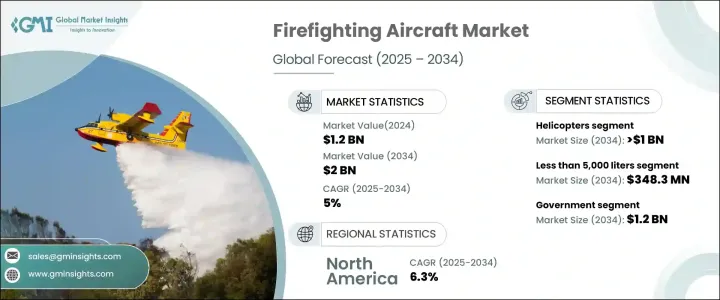PUBLISHER: Global Market Insights Inc. | PRODUCT CODE: 1698314

PUBLISHER: Global Market Insights Inc. | PRODUCT CODE: 1698314
Firefighting Aircraft Market Opportunity, Growth Drivers, Industry Trend Analysis, and Forecast 2025-2034
The Global Firefighting Aircraft Market generated USD 1.2 billion in 2024 and is projected to expand at a CAGR of 5% between 2025 and 2034, driven by the increasing frequency and intensity of wildfires worldwide. Climate change has exacerbated wildfire risks, leading to longer fire seasons and higher demand for efficient aerial firefighting solutions. Governments and private organizations are actively investing in advanced aircraft to ensure rapid response and effective suppression of fire outbreaks. The need for modernized firefighting fleets is growing, with an emphasis on improved aircraft performance, enhanced water-carrying capacity, and better maneuverability in high-risk zones.

The market comprises helicopters, fixed-wing aircraft, and unmanned aerial vehicles, each playing a critical role in wildfire suppression. Helicopters, in particular, are expected to generate USD 1 billion by 2034 due to their versatility in reaching remote areas and transporting large volumes of water. These aircraft are increasingly integrated into fire suppression operations, offering rapid response capabilities and the ability to douse large-scale fires efficiently. As wildfires become more frequent and intense, aerial firefighting fleets are being expanded to strengthen emergency response efforts. Technological advancements, including night-vision capabilities and improved water-dropping systems, are enhancing the effectiveness of helicopters in challenging fire conditions.
| Market Scope | |
|---|---|
| Start Year | 2024 |
| Forecast Year | 2025-2034 |
| Start Value | $1.2 Billion |
| Forecast Value | $2 Billion |
| CAGR | 5% |
Government-operated firefighting aircraft are projected to reach a market value of USD 1.2 billion by 2034, fueled by increased investments in fire prevention and disaster management strategies. The market is segmented into government agencies and private contractors, both of which play a vital role in wildfire suppression. These entities are deploying specialized aircraft to detect, control, and extinguish fires at an early stage, minimizing damage and ensuring public safety. Proactive measures are being taken to modernize firefighting fleets with advanced aircraft featuring improved efficiency, longer flight endurance, and enhanced aerial mapping capabilities. As climate change continues to heighten fire risks, governments worldwide are prioritizing aerial firefighting solutions to mitigate potential disasters effectively.
The U.S. firefighting aircraft market reached USD 398.4 million in 2024 and is anticipated to grow at a CAGR of 6.3% between 2025 and 2034. With prolonged wildfire seasons becoming more common, aerial firefighting has become an indispensable component of emergency response strategies. Changing climate patterns have made fire seasons increasingly unpredictable, requiring continuous expansion and optimization of firefighting resources. The rise in overnight fires presents additional challenges, leading to greater reliance on advanced aircraft equipped with thermal imaging and enhanced night-operation capabilities. As wildfire risks escalate, the focus remains on optimizing aerial firefighting operations to ensure rapid response times, minimize destruction, and protect high-risk regions effectively.
Table of Contents
Chapter 1 Methodology and Scope
- 1.1 Market scope and definitions
- 1.2 Research design
- 1.2.1 Research approach
- 1.2.2 Data collection methods
- 1.3 Base estimates and calculations
- 1.3.1 Base year calculation
- 1.3.2 Key trends for market estimation
- 1.4 Forecast model
- 1.5 Primary research and validation
- 1.5.1 Primary sources
- 1.5.2 Data mining sources
Chapter 2 Executive Summary
- 2.1 Industry 360° synopsis
Chapter 3 Industry Insights
- 3.1 Industry ecosystem analysis
- 3.2 Industry impact forces
- 3.2.1 Growth drivers
- 3.2.1.1 Rising wildfire globally
- 3.2.1.2 Increase in firefighting aircraft services
- 3.2.1.3 Technological advancements in firefighting aircraft
- 3.2.1.4 Rising support from the government and defense in tackling fires
- 3.2.2 Industry pitfalls and challenges
- 3.2.2.1 High cost associated with aerial firefighting operations
- 3.2.2.2 Limited number of firefighting aircraft available
- 3.2.1 Growth drivers
- 3.3 Growth potential analysis
- 3.4 Regulatory landscape
- 3.5 Technology landscape
- 3.6 Future market trends
- 3.7 Gap analysis
- 3.8 Porter's analysis
- 3.9 PESTEL analysis
Chapter 4 Competitive Landscape, 2024
- 4.1 Introduction
- 4.2 Company market share analysis
- 4.3 Competitive analysis of major market players
- 4.4 Competitive positioning matrix
- 4.5 Strategy dashboard
Chapter 5 Market Estimates and Forecast, By Aircraft, 2021 – 2034 ($ Mn)
- 5.1 Key trends
- 5.2 Helicopter
- 5.2.1 Type 1
- 5.2.2 Type 2
- 5.2.3 Type 3
- 5.3 Fixed wing aircraft
- 5.4 Unmanned aerial vehicles
Chapter 6 Market Estimates and Forecast, By Water Capacity, 2021 – 2034 ($ Mn)
- 6.1 Key trends
- 6.2 Less Than 5,000 Liters
- 6.3 5,000–10,000 Liters
- 6.4 More Than 10,000 Liters
Chapter 7 Market Estimates and Forecast, By End use, 2021 – 2034 ($ Mn)
- 7.1 Key trends
- 7.2 Government
- 7.3 Private contractors
Chapter 8 Market Estimates and Forecast, By Region, 2021 – 2034 ($ Mn)
- 8.1 Key trends
- 8.2 North America
- 8.2.1 U.S.
- 8.2.2 Canada
- 8.3 Europe
- 8.3.1 Germany
- 8.3.2 UK
- 8.3.3 France
- 8.3.4 Spain
- 8.3.5 Italy
- 8.3.6 Netherlands
- 8.4 Asia Pacific
- 8.4.1 China
- 8.4.2 India
- 8.4.3 Japan
- 8.4.4 Australia
- 8.4.5 South Korea
- 8.5 Latin America
- 8.5.1 Brazil
- 8.5.2 Mexico
- 8.5.3 Argentina
- 8.6 Middle East and Africa
- 8.6.1 Saudi Arabia
- 8.6.2 South Africa
- 8.6.3 UAE
Chapter 9 Company Profiles
- 9.1 Air Tractor, Inc.
- 9.2 Airbus
- 9.3 De Havilland Aircraft of Canada Limited.
- 9.4 HYNAERO
- 9.5 Kaman Corporation.
- 9.6 Leonardo S.p.A.
- 9.7 Lockheed Martin Corporation
- 9.8 MD HELICOPTERS LLC.
- 9.9 ShinMaywa Industries, Ltd.
- 9.10 Textron Inc.




